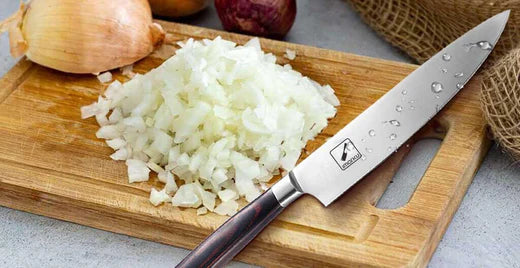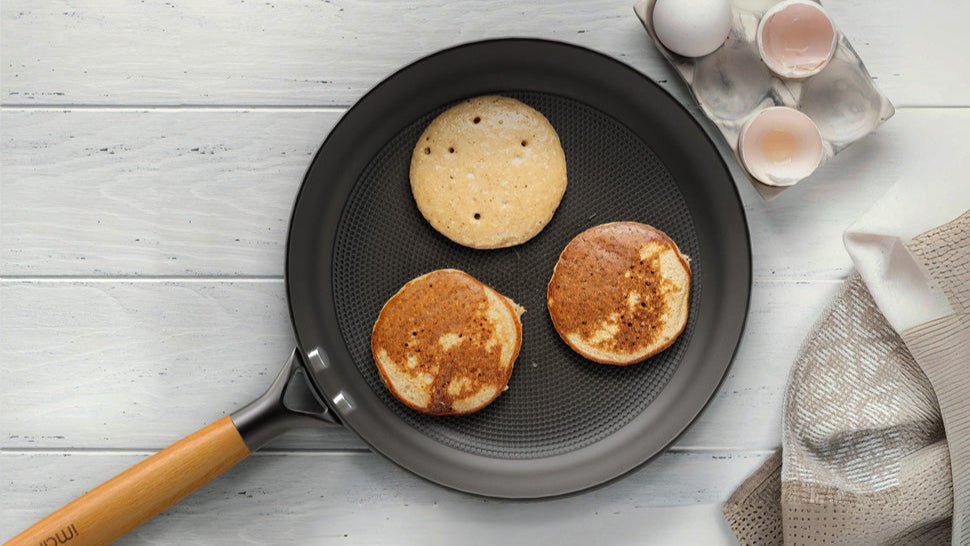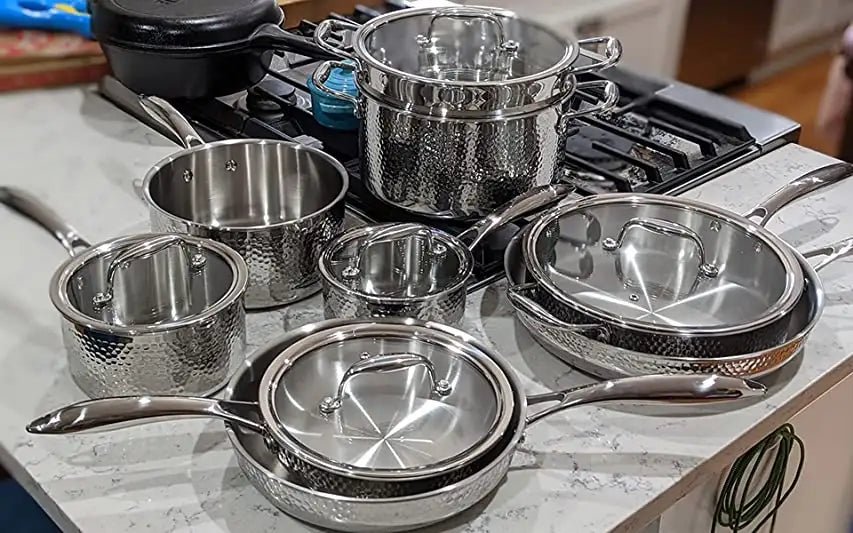TABLE OF CONTENTS
There are several types of knives available that you may want to add to your culinary collection. But if you are a passionate chef or a professional looking out for a brilliant knife for various types of cuts and slices, you must invest in a Japanese Nakiri knife.
Moreover, a Nakiri knife lets you craft thinner and even slices because of the straight structure of the blade. As a result, you will have smoother cuts without spoiling or breaking delicate greens.

What is a Nakiri knife?
A nakiri knife is a classical kitchen blade crafted by the Japanese with a straight and symmetric edge. The word "Nakiri" in Japanese means "leaf cutter," highlighting its intended use for slicing and dicing leafy vegetables.
The Nakiri knife's significance in the kitchen lies in its ability to create clean and precise cuts, making it ideal for preparing vegetables for various culinary applications.
It resembles a cleaver in structure and is perfectly suited for slicing eggplants, dicing onions, and julienne tomatoes or other veggies. Once you lay your hands on this brilliant Japanese creation, it will soon become your favorite tool for easy chopping and quick slicing.
Difference between Nakiri knife and other kitchen knives
Unlike other kitchen knives, such as the chef's knife or Santoku knife, which have curved blades, the Nakiri knife has a straight edge, making it ideal for making clean, precise cuts on vegetables.
The Nakiri knife is also designed with a thinner blade, allowing for efficient slicing through vegetables without crushing or tearing them. Overall, the Nakiri knife is a specialized tool for vegetable preparation that differs from other kitchen knives in its blade shape and cutting technique.
What is the best materials for a Nakiri knife?
The best materials for a Nakiri knife are typically high carbon stainless steel that is tempered to a high Rockwell hardness (HRC) for durability and edge retention, such as SG2 or VG-10 steel known for their exceptional performance and sharpness .
Additionally, the construction and design of the knife, such as a thinner blade with a hollow ground or granton edge, can reduce friction and sticking of foods for more efficient chopping of meat and vegetables.
The handle material, such as traditional wood or modern synthetic materials like G10 or Micarta, is also significant for comfort and grip. Overall, the best Nakiri knife should have high-quality blade material, efficient construction and design, and a comfortable handle material.

Can a Nakiri knife be used for both vegetables and meat?
Yes, a nakiri knife can be used for both vegetables and meat due to its square-tip blade design, which allows for efficient chopping and slicing. The hollow ground or granton edge of a nakiri knife helps reduce friction and sticking of foods, making it versatile for various cutting tasks.
However, it's important to note that nakiri knives are primarily designed for slicing through vegetables and are not ideal for heavy-duty meat cutting tasks such as bone-in cuts or dense cuts of meat.
How to use and maintain a Nakiri knife?
When you use a nakiri knife for slicing vegetables, you must follow a predefined pattern. Since it comes with a straight tip, it is very easy to use. You will have to move the knife in an up and down motion rather than a horizontal motion. You must keep your fingers bent, forming a claw shape and use the knuckles to hold the vegetables in place.
Now, you can glide the knife while touching the knuckles slightly. Move-in a straight direction for an even cut and you will notice your knife reaching to the chopping board without applying any extra force. You may need some practice to acquire the skill of using a nakiri knife.
Using a nakiri knife will require a good chopping board and keep it on a flat surface while cutting on it. The grip should be substantial while being comfortable. Holding the knife in the right way is one of the most important chopping rules.
Even though nakiri is mainly developed for cutting vegetables, you may also use it for cutting soft flesh like chicken or fish. But since it has a thinner and lighter blade, you mustn’t use it for deboning fish or meat bones.
To maintain a nakiri knife, it is important to keep it sharp and clean. Regularly sharpen the blade using a sharpening stone or honing rod, and clean it with mild soap and water, avoiding harsh abrasives that can damage the blade.
Dry the knife thoroughly to prevent rusting and store it in a dry place. Proper maintenance will ensure the longevity and performance of your nakiri knife for years to come.

How to choose the best Nakiri knife?
Shopping for a nakiri knife may appear to be a simple task, but there are several considerations that you must factor in to ensure that it turns out to be a valuable investment. Let’s take a look at the few important aspects.
Material of the blade
The most crucial consideration for your nakiri knife is the blade material. The modern knives are made of stainless steel mostly but all of them are not created equal. When shopping for any Japanese kitchen blades, you will see two types of stainless steel: high carbon and low carbon. All stainless steel comes with some amount of carbon and the amount actually determines the class of the blade.
- Low carbon: A kitchen blade with low carbon content will become much quicker compared to its counterpart with high carbon content. With carbon content, the blades are softer and you need to sharpen your blade quite often.
- High carbon: This type of blade does hold its sharpness for a very long time, sometimes, for years together. Moreover, these knives are very easy to sharpen. You won’t have to care much about its maintenance and care.
If durability and quality are your top concern, your nakiri knife should have high carbon stainless steel.
Finish of the blade
When you are chopping, veggies and herbs are prone to stick to the blade. But with the right finish of the blade, you can steer clear of this unnecessary happening. Many nakiri knives come with a hammered finish termed as tsuchime in the Japanese language.
Hand-hammered finishes are crafted for reducing chances of drag while cutting and don’t allow food to stick. You can also opt for a kitchen blade with a Granton Edge for achieving the same thing. While chopping, it forms air pockets and helps food particles to release off the blade.
Handle
Besides the quality of the blade, you will also have to consider the quality of the handle. It must be very comfortable to use and shouldn’t cause discomfort or numbness even after years of use. Your nakiri bocho should have a firm grip since a slippery grip can lead to unforeseen injuries.
Ergonomic design
Nakiri knives are ergonomically designed with someone narrow and slightly curved blade. This helps in alleviating ginger pain and tiredness from a longer span of operation. The construction of the handle is so responsible for this. The handle goes through several treatments that make the knives impervious to cold, heat, and moisture.

Top brands of Nakiri knives in the market
Shun Classic 6 1/2-Inch Nakiri Knife: It features a squared-off tip and a straight cutting edge, making it ideal for handling a variety of vegetables with ease. Its efficient design allows for both slicing and dicing tasks. With a shorter 7-inch length, this knife is easy to handle and provides precision cuts while still being long enough for versatility.
The Yoshihiro VG-10 16 Layer Hammered Damascus Nakiri Knife: Known for its exquisite craftsmanship, this knife delivers exceptional sharpness and durability with 16 layers of hammered Damascus steel. Its unique design and quality materials make it a reliable choice for efficient vegetable preparation.
The TUO Nakiri Knife 6.5-Inch With Pakkawood Handle: It is a versatile and reliable option. Featuring a durable and beautiful ebony-finished Pakkawood handle, this knife is comfortable to use for both left- and right-handed users. Its straight blade and edge make it perfect for precise push cuts, while the shorter length allows for easy maneuverability.
The Miyabi Evolution 6.5-Inch Nakiri Knife: Made with a Japanese VG10 stainless steel blade, it is known for its high-quality construction and it delivers exceptional sharpness and corrosion resistance. Its ergonomic handle provides comfort and control during use. The 6.5-inch length is ideal for efficient vegetable preparation tasks.
Imarku Nakiri Knife 7" AUS10 Hammered
Featuring a squared-off tip and a straight cutting edge, this exquisite blade is purposefully designed to effortlessly handle a wide variety of vegetables. It excels not only in slicing but also in dicing tasks with exceptional efficiency.
The shorter 7-inch length of the blade makes it easier than ever to manage precision cuts, while still providing enough length for versatility and versatility in vegetable preparation.
Imarku Damascus Nakiri Knife 6''
With its 6-inch size, this Kiritsuke knife from imarku delivers outstanding cutting performance and versatility. Its exceptional sharpness is maintained over time through our meticulous manual sharpening process, which is done one at a time due to the delicate nature of the blade.
This allows it to effortlessly slice through any vegetable or protein with ease, making it a reliable tool in the kitchen for various tasks.






















Leave a comment
All comments are moderated before being published.
This site is protected by hCaptcha and the hCaptcha Privacy Policy and Terms of Service apply.